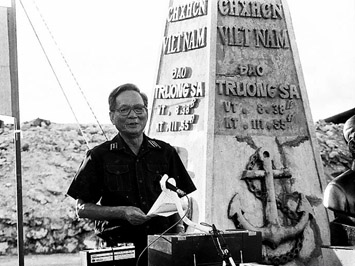 |
|
General Le Duc Anh, former Minister of National Defence, visiting the Spratlys in 1988 (file photo) |
Since the April 30th 1975 victory, the State of Socialist Republic of Vietnam has controlled all its territories, including Hoang Sa (Paracels) and Truong Sa (Spratlys). Accordingly, together with the organizing of forces to control and protect seas and islands, the State of Vietnam released various legal normative documents on Hoang Sa and Truong Sa. A typical example was the Vietnam Government’s Statement on Territorial Waters, Contiguous Zone, the Exclusive Economic Zone and the Continental Shelf of May 12th 1977; the Statement on Vietnam’s complete control of Hoang Sa and Truong Sa, made by the Ministry of Foreign Affairs 1994, and decisions on the establishment of administrative units in the archipelagos. On that basis, the Government of Vietnam conducted a number of activities to exercise its sovereignty over Hoang Sa and Truong Sa, such as displaying historical exhibits; studying climate and ground; building sovereignty stales and lighthouses, setting up residency on islands. To date, in Truong Sa, Vietnam has had 9 lighthouses (recognized on the international nautical chart by the International Association of Lighthouse Authorities); simultaneously groups of residency on islands with essential facilities, such as housing, schools, medical stations, sea ports, cultural establishments (libraries, pagodas), etc., were set up. Those are globally recognized as the liveliest manifestation of Vietnam’s sovereignty over the two archipelagos.
Regarding administration, in 1982, the Government of Vietnam established the island district of Hoang Sa (under the province of Quang Nam-Da Nang) and the island district of Truong Sa (under the province of Dong Nai). Today, (after adjustments in administrative divisions), Hoang Sa district is under Da Nang city, and Truong Sa district is under Khanh Hoa province. To satisfy the developments of practice, in 2007, the Government decided to establish the township of Truong Sa and two island communes, namely Song Tu Tay and Sinh Ton under Truong Sa district.
Moreover, Vietnam has continued to fight for its irrefutable sovereignty over Hoang Sa and Truong Sa against foreign occupation. In September 1975, in the World Meteorological Congress held in Colombo, alongside reaffirming its sovereignty over Hoang Sa and Truong Sa, Vietnam registered a Weather Station in Hoang Sa in the World Meteorological Organization’s SYNOP system (coded 48.860), receiving the organization’s acceptance. In the 2nd International Congress on Asia Meteorology (June 1980), the International Geological Congress (July 1980), and the World Wireless Telegraph (January 1983), Vietnam relentlessly unmasked and denounced China’s taking advantage of the fora to propagate the so-called China’s sovereignty over Hoang Sa and Truong Sa, and clearly claimed Vietnam’s sovereignty over the two archipelagos, in accordance with the rules of international law. Notably, in the Asia-Pacific Aerospace Conference (1983) held in Singapore, when China took advantage of its illegal occupation of Hoang Sa to expand the Flight Information Region (FIR) of Guangzhou down to the South, the Conference rejected it and maintained the status quo. Besides, Vietnam continuously released the White Paper on its sovereignty over Hoang Sa and Truong Sa in 1979, 1981, and 1988, which was recognized by the international community.
All mentioned facts show that Vietnam has sufficient legal basis and historical evidence to claim its sovereignty over Hoang Sa and Truong Sa.
Ta Quang